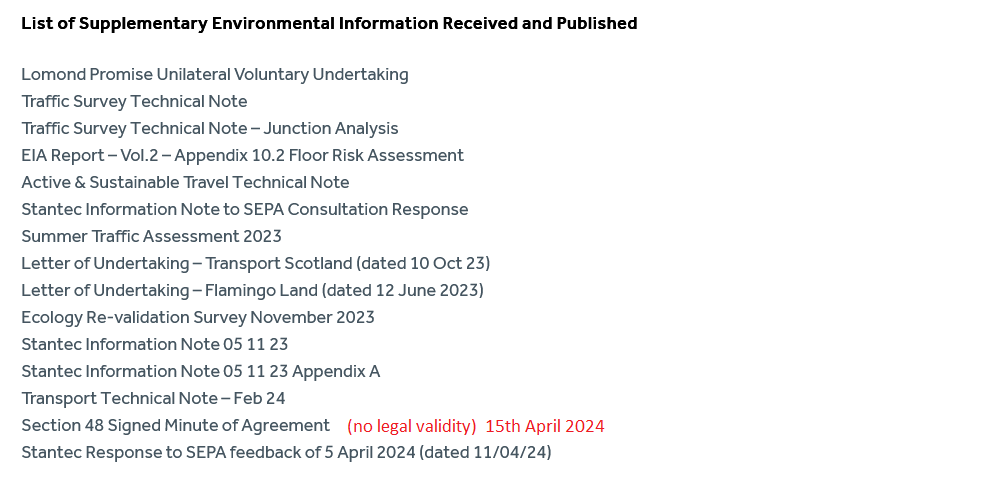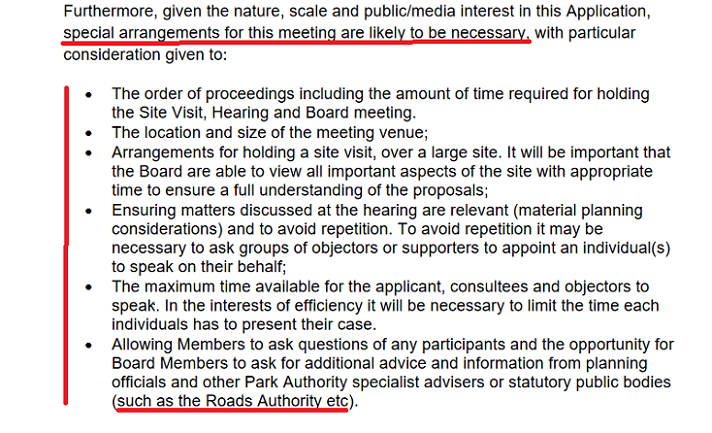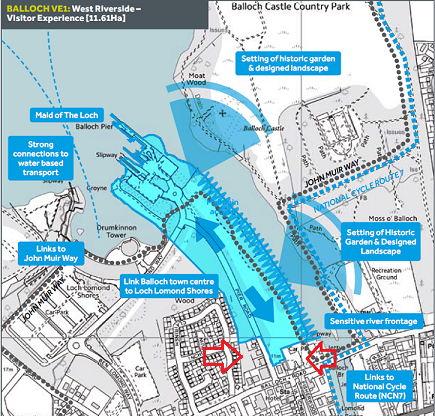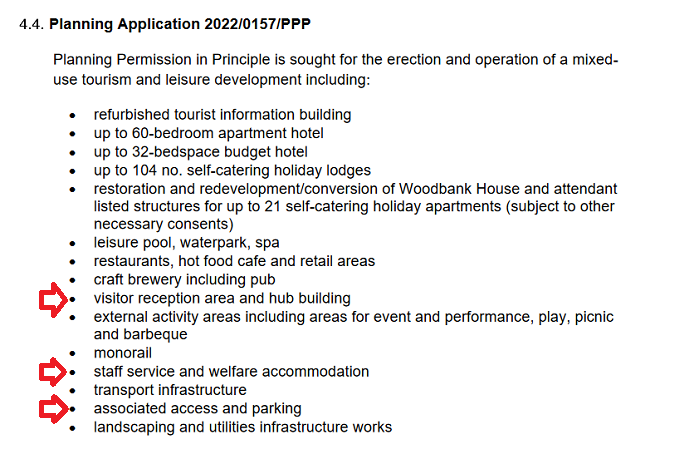
On 16th July the Loch Lomond and Trossachs National Park Authority (LLTNPA) issued a news release (see here) stating its board had agreed a date, Monday 16th September, to take a decision on the (Mark III) version (see here) of the Flamingo Land Planning Application.
This post will argue that the content of the news release and supporting information show that senior staff at the LLTNPA – who were involved in appointing Flamingo Land as preferred developer for Balloch (see here) – are even more in control of the whole planning process than previously.
What they will recommend, however, remains in the balance. In the two days following the LLTNPA’s announcement a further 23,000 people objected to the proposed development through the Green Party (see here), taking the overall number of objections past 100,000. This is a political crisis of the LLTNPA’s own making and one which the senior staff who decide everything that happens in the National Park will find difficult to ignore.
Arrangements for the Board Meeting on 16th September
The news release claims that the LLTNPA Board “agreed today” the arrangements for 16th September. This is highly misleadling. There was no board meeting on 16th July. Only by clicking on the link to the board paper (see here) does it become apparent that the decision was made by “correspondence” – which presumably took place over time and was not just on a single day.
Under clause 51 of the LLTNPA’s standing orders (see here):
“Exceptionally, if a Board decision is required urgently and it is not possible to convene a meeting, the Convener or Depute Convener may decide to deal with the matter through correspondence.”
The LLTNPA has not explained why it has suddenly become so urgent to determine the revised Flamingo Land application, which was first submitted in May 2022, or why it wasn’t possible to hold a special board meeting to consider the paper in public. Nor is there any explanation of why the paper could not have been considered at the LLTNPA board meeting which took place on 10th June – more evidence for my contention that most of what matters in the National Park is either discussed in secret or not at all (see here).
Instead, the news release contains this misleading statement:
“Officers now have all the information required to assess the application and that assessment will continue between now and September.”
This implies that the LLTNPA received the final bits of information officers required to produce a report on the application at some time between 10th June and 16th July. The Committee Report shows that didn’t include information from the developer most of which had been submitted by the end of last year:

Moreover, a perusal of the planning portal (see here) shows that no information that could be considered “materially significant” has been submitted since 10th June. All there is – besides contributions from the public – is a response from Scottish Water, dated 5th July. This confirms Scottish Water has sufficient capacity at the Finlas Water Treatment works and at the Ardoch Waste Water Treatment works to service the development. However, Scottish Water had provided an almost identical response back in March 2023 and it is unclear why they should have been asked to do so again. The conclusion should be clear. Unless crucial correspondence has still not been published on the planning portal, there is no valid reason why the paper setting out the arrangements for the Flamingo Land decision could not have been discussed in public on 10th June.
The evidence for how the first Flamingo Land application was handled lends further support to that view. At the LLTNPA meeting held on 17th June 2019 the then board considered a paper setting out the arrangements for a special meeting to decide the application. This paper left it to staff to decide the actual date for the board meeting. The LLTNPA could have done exactly the same at their board meeting this June.
However, had they done so, that might have highlighted the fact that the timing of the paper presented to the June Meeting meeting to revise the Code of Conduct for board members (see here) was more than just a coincidence and intended to stop them asking any questions about the forthcoming Flamingo Land planning application. Moreover, the last thing the cabal that run the National Park wanted was to give the locally elected board member for Balloch, Sid Perrie, an opportunity to ask more critical questions in public about the whole process. Hence, the decision by the Convener, Dr Heather Reid, to ask the Board to agree arrangements for the meeting on 16th September by correspondence.
The significance of this lack of public scrutiny is that it has enabled responsibility for the “special arrangements” for the board meeting on 16th September to be handed to the LLTNPA’s senior management – the very people who agreed Park staff should be on the interview panel which appointed Flamingo Land as preferred developer:

Set aside the practicalities about finding a suitable venue, the key point is that in the absence of the LLTNPA Board agreeing alternative arrangements, the special meeting will be arranged according to the Park’s Standing Orders. These state that where planning applications are considered by the main board, the standing orders of the Planning and Access Committee will apply. Those standing orders were – completely by coincidence you understand – “updated” at the main board meeting in June, the one which failed to mention the Flamingo Land planning application. They allow just two representations from those opposing a planning application, both limited to five minutes. Since one of those “slots” will be reserved for Balloch and Haldane Community Council, this means ALL the other objectors will have to share one five minute slot.
Those objectors include: Jonathan McColl, local councillor and former leader of West Dunbartonshire Council (who in his objection eexplicitly asked to speak at the meeting); the planning expert representing Ross Greer MSP and the Green Party; organisations such as the Woodland Trust, National Trust for Scotland, Rambles Scotland; the Save Loch Lomond campaign; local businesses such as Loch Lomond Shores who have objected to the takeover of their car park; and local people who have made detailed submissions on specific aspects of the application.
While the Board has the power to suspend their standing orders, doing so at the special board meeting scheduled for September would be far too late and a recipe for chaos. There is clearly no way on the day that either the board or people/organisations attending can can sort out who is going to speak and when. What the LLTNPA board now needs to do therefore is to call a special board meeting before the 16th September where it agrees to suspend normal standing orders and puts in place special arrangements for the meeting to allow sufficient time for public representations.
That, however, would undermine the power of the Chief Executive, Gordon Watson, and Director of Development, Stuart Mearns who have been behind the proposed development for Balloch from the start. They want to restrict public scrutiny and comment on whatever report they present to the meeting on 16th September to the minimum possible. Hence why their paper to the board failed to explore any options for giving the public a fair hearing.
Do LLTNPA staff now really have the information required by the board to take a decision?
There are still some major gaps in the information supplied by Flamingo Land both in respect of what they are actually proposing and how this is compatible with the Development Plan which consists of the old Park Local Development Plan – now well out of date – and National Planning Framework 4.

While the boundary of the planning application was amended in the Mark III application, the rational for this has not been clearly explained. It still covers more land at Balloch than was allocated in the LLTNPA’s Local Development Plan for “visitor experience”.
While the Service Area (10 above), which Flamingo Land proposed to site in ancient woodland, was removed from the Mark III application, the strip of “managed woodland” along Old Luss Rd remains. That strip of planted woodland, like Drumkinnon woods, was never allocated for development in the Park’s Local Development Plan. With the whole of the Drumkinnon Woods ancient woodland now having been removed from the application, which seeks consent to the principle of development, why not also this managed woodland? Unless, of course, Flamingo Land other plans for it?

Moreover, not all of the Riverside Site was allocated for “Visitor Experience” in the Local Development Plan although almost all the area by Balloch Rd is still included in the planning application. That area includes the car parks, used and valued by local people for “park and ride”, and the building formerly used as a Visitor Centre which the local community now wish to take over for their own use (see here). That LLTNPA planning staff do not appear to have asked Flamingo Land to amend further the proposed boundaries of the application provides more evidence that they are putting development interests before the interests of local people.
While the boundary of the proposed development was amended in the Mark III application, the content of what was to be included within that boundary remains the same:

Having searched again through the revised design statement, I can still no spaces allocated to two core elements of the development, the “visitor reception area” and the “staff service and welfare accommodation”. Both were originally to be located in Drumkinnon Woods but, after Flamingo Land were forced to remove them due to public outcry, the LLTNPA has still not required the developer to show where they will be located and how they might impact on other elements of the proposals. Why not?
A related point concerns the impact of the proposed development on neighbouring land. For example, one of the early objectors to the proposed development n was Loch Lomond Shores who opposed any use of their car park by Flamingo Land because of the potential impact on their business. All this was to be discussed with Scottish Enterprise who wish to sell the Riverside Site to Flamingo Land but there is nothing on the planning portal to show the outcome of those discussions or whether they have been resolved.
There are also major gaps in the planning documentation about how the development is compatible with planning policy and more specifically NPF4 which now takes precedence over policies in the Local Development Plan. For example, while Flamingo Land has submitted a revised Flood Risk Assessment for the central part of the Riverside Site which shows it is at risk of flooding, it has provided no information to show that IF their if their chalet development was given the go ahead then “long-term safety and resilience can be secured in accordance with relevant SEPA advice”.
As for matters like the impact of the development on carbon emissions – something that is now supposed to be considered under NPF4 – there has been no assessment, only vague promises about the use of “green energy”. In fact there is almost nothing in the application which demonstrates how the proposed development will contribute to the National Park’s pivotal moment.
I hope this fairly brief summary of some of the key planning issues should make it clear there are still huge holes in the planning documentation. That begs the question as to why the LLTNPA are now claiming they are in a position to reach an objective decision? Either their claim to have all the documents they need to just wrong or they have given up trying to extract the required information from Flamingo Land and have decided to reject the application.
What will LLTNPA staff recommend to their board?
While huge emphasis is now put on the quasi-judicial nature of the planning system, in practice that system as managed by the LLTNPA is anything but objective and fair.
This situation has come about because the LLTNPA Board has never been prepared to challenge their senior management or properly investigate the involvement of their Chief Executive and Director of Development in the appointment of Flamingo Land (as previously promised, I will bring together all the evidence for that involvement in one single post). Given the degree of control that those staff now have over board members, it appears highly unlikely they will agree anything on 16th September except what is recommended to them by LLTNPA staff in the Committee Report.
Those senior staff, however, while having spent years supporting the Flamingo Land development, are not stupid and will change position according to the political winds. Whatever the claims being made about the objectivity of the “quasi judicial process”, ultimately whether they accept or reject the sort of points made in this post will be decided on political grounds. Their careers depend on it.
I therefore expect the report currently being drafted to be finely “balanced” between points favouring the principle of development on the Bonnie Banks to points against – when actually a development such as what is proposed should never have been contemplated in the National Park. All it will then take is for senior management to amend a few words here and there to alter the overall recommendation. That decision may be left to the last moment or senior staff may even delay the decision-making meeting, as allowed for in the Committee Report, until they are clear which way the political winds are blowing.
Ascertaining those political winds is now more complicated than it was due to the outcome of the UK elections, the recovery of the Labour Party in Scotland and the UK Government and Scottish Governments now apparently being prepared to work more closely together. While the SNP, influenced by the Greens and local opinion, appear to have gradually moved away from supporting Flamingo Land, the local Labour Party have moved in the opposite direction (see here) and we now have a UK Labour Government that sees private sector investment as the key to economic growth and is threatening to make the planning system even more friendly towards development.
How those tensions get played out is still not determined. Maintaining public pressure on all the political parties therefore should be a key concern for all those who want to preserve the character of Loch Lomond and make Balloch a better place. In short, as well as submitting objections to the development it is equally important the public contact the representatives of the various political parties and let them know what they think.

Yet another piece of extremely well documented research, Nick. Further to all your very valid points ‘re the lack of opportunity for the public /interested parties to speak at the “Board” Meeting, it is extremely unlikely that the Meeting will be webcast live or video recorded for pubic viewing on any media channel such as YouTube. In the recent past the choice of venue for various LLTTNPA meetings, e.g. Lomond Church Hall, has been a “get out” excuse by LLTTNPA for not sharing these public meetings with those members of the public who are unable to attend in person.
i think you need to consider the objectives of LLTNP. Despite what they state, there is no evidence, historically or otherwise that this organisation is committed to ecosystem protection. On the contrary, they are predominantly focussed on the commoditisation of Nature purely for financial gain for the few. For them, the board, they view Flamingo Land as a perfect fit for expanding facilities for visitors. Their only concern right now is how to support it but be seen to have a concern for the natural environment that will be replaced with concrete.
I agree but the LLTNPA has also completely ignored the cultural heritage at Balloch, part of which is the way people living in the area have enjoyed the loch, whether for a view, for boating etc